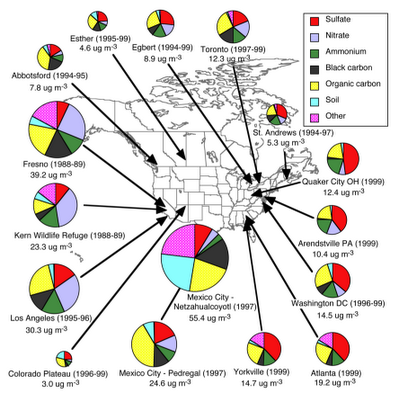Particulate matter (PM) is a complex mixture of different chemicals species whose composition depends upon the source of the emissions.
The primary species found in PM2.5 are:
- Sulfur – formed from SO2 gases. Condensable species are formed by reactions in the atmosphere. A key sulfur aerosol compound is sulfuric acid, an acidic particle that is also important in acid rain. The primary source of SO2 emissions is coal combustion, which is why acid rain and acidic degradation of surfaces in the east coast.
- Nitrogen – formed from NO and NO2 gases and also form condensible species in the atmosphere. These gases, referred to collectively as NOx, are emitted from combustion processes. There are a larger variety of nitrogen species found in aerosols, the most important being nitric acid (another acidic aerosol) and ammonium nitrate.
- Organic Carbon – there are a seemingly infinite number of chemical compounds found in organic carbon aerosols, described as either primary or secondary. Primary organic carbon aerosols are directly emitted, mostly from combustion processes. An example is the smoke coming from cooking meat – that whitish looking smoke that comes from a good BBQ joint. Secondary organic carbon aerosol are formed by chemical reactions of organic gases in the atmosphere. Basically, volatile organic carbons (paint fumes, gas fumes, terpentine, house air “purifiers”, and on and on, cook up in the atmosphere and form all kinds of condensible species.
- Black Carbon – these particles are carbonaceous aerosols that are directly emitted from combustion and are dark, hence the term black carbon. Basically, these particles are the soot coming from diesel trucks and buses, or from candles, or from burning wood. The chemical structure of the particles is a lot like graphite or charcoal.
(Interesting geek fact – the yellow color of candle flames comes from high temperature radiance coming from the soot in the flame. <Snort.>)
PM10 is primarily composed of crustal elements, sea salt, and metals from different industrial processes.
The composition of aerosols vary across the US. The following graphic shows the composition at a number of cities in the US (and Mexico). The size of the circle reflect the mass concentration with the different pie colors representing the amount of that particular chemical in the aerosol.
